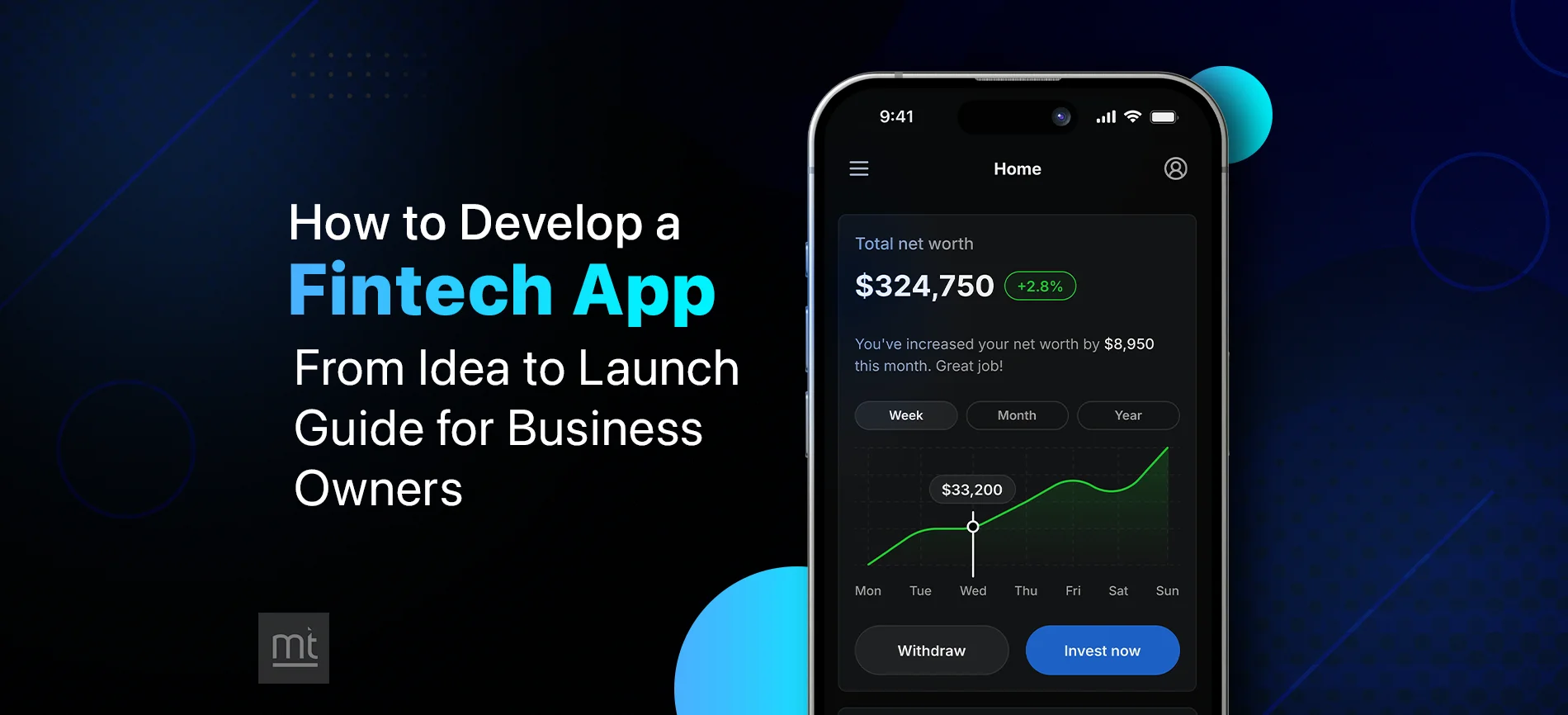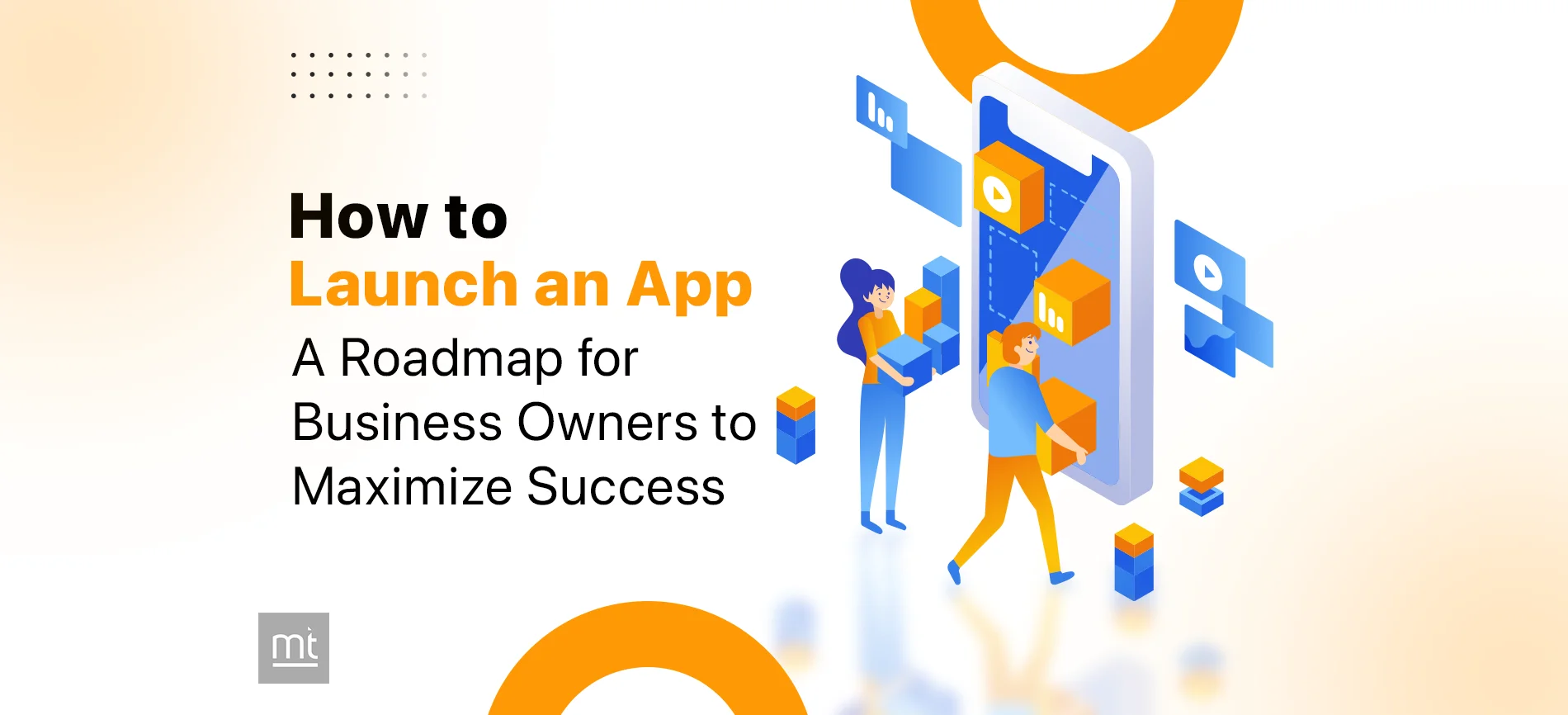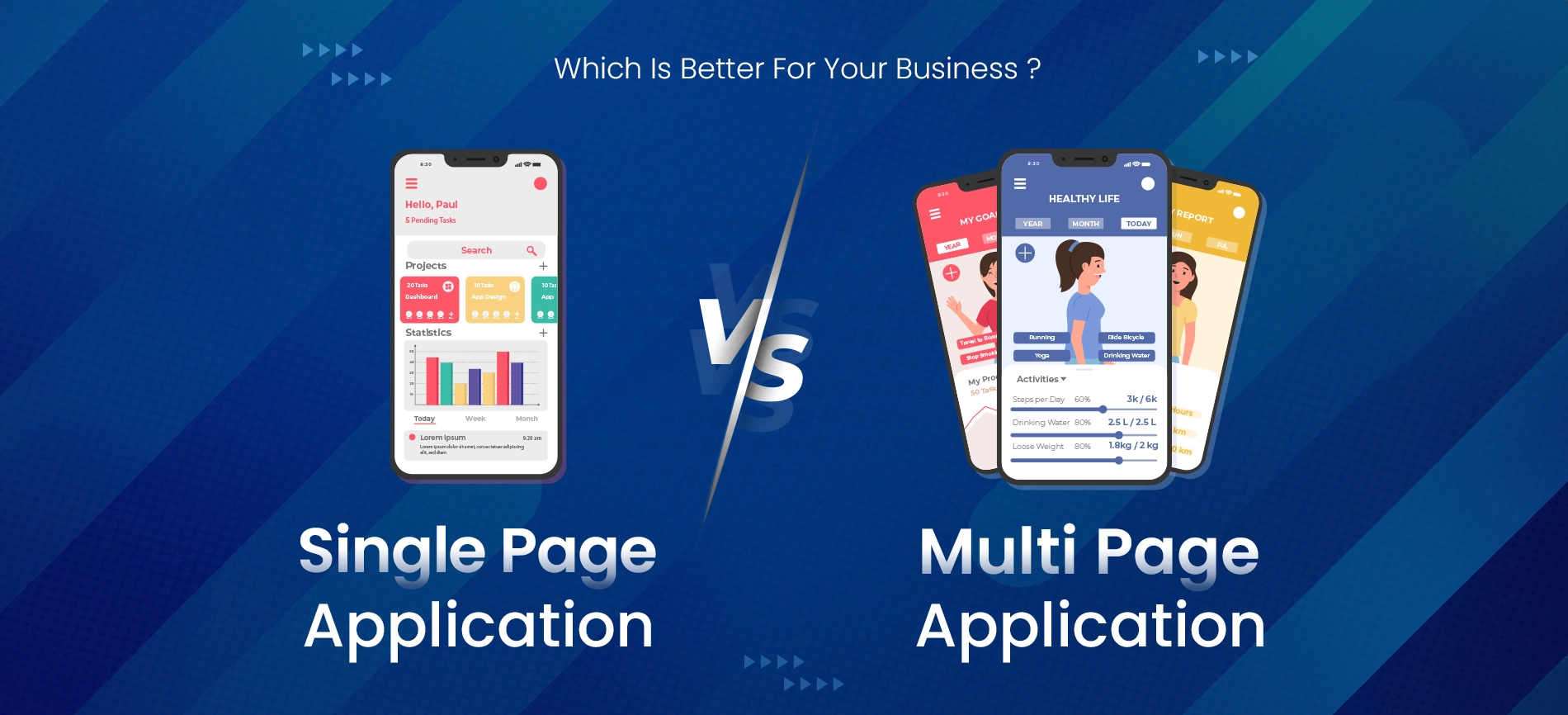Introduction:
Today, no businesses want to halt their payments due to distance and limited payment options. This is where counting on the idea of UPI Payment App Development plays an important role in facilitating digital payments. Online payment apps make it easier for individuals and businesses to make or receive payments at a click.
From a secure payment gateway, a faster payment process, and no minimal transaction fees, Payment app development delivers the best stage for you. Whether you want to pay electricity bills to mobile recharge, a payment app can bring every feature under one roof.
According to reports, digital payment is growing significantly and registering staggering growth with convenience and flexibility. However, there are lots of steps and detailed processes to develop a Payment app and taking the right steps can land in developing world class and feature rich payment apps.
Here, we will cover everything about payment app development, from processes and features to challenges.
About Payment Apps
Payment apps' quick, secure, and effortless nature has revolutionized financial transactions. These apps make Online money transfers possible; cards and cash are unnecessary. While some payment apps are sophisticated platforms for international transactions and cryptocurrency trading, others are just simple P2P transfer services.
Easy use of the payment app is a big advantage. Users may use their PCs or smartphones to handle, transfer, and pay their accounts at any time and from any location. Today's internet world is quite fast-paced, making this accessibility very helpful. Payment systems also provide transaction records, real-time notifications, and spending data to assist consumers in handling their money and making wise decisions.
The development and use of payment apps depend critically on security. Fintech data protection requires sophisticated encryption, safe authentication, and regulatory compliance. Giving users greater money management options, these apps also connect with payment methods and banking institutions. Online payments are commonplace. Payment app users are growing yearly, with 32% owning several mobile wallet applications.
Types of Payment Apps
There are various types of payment apps available in the market that work to ease your payment transaction. Let’s consider various types of payment apps to get on track with seamless payments:
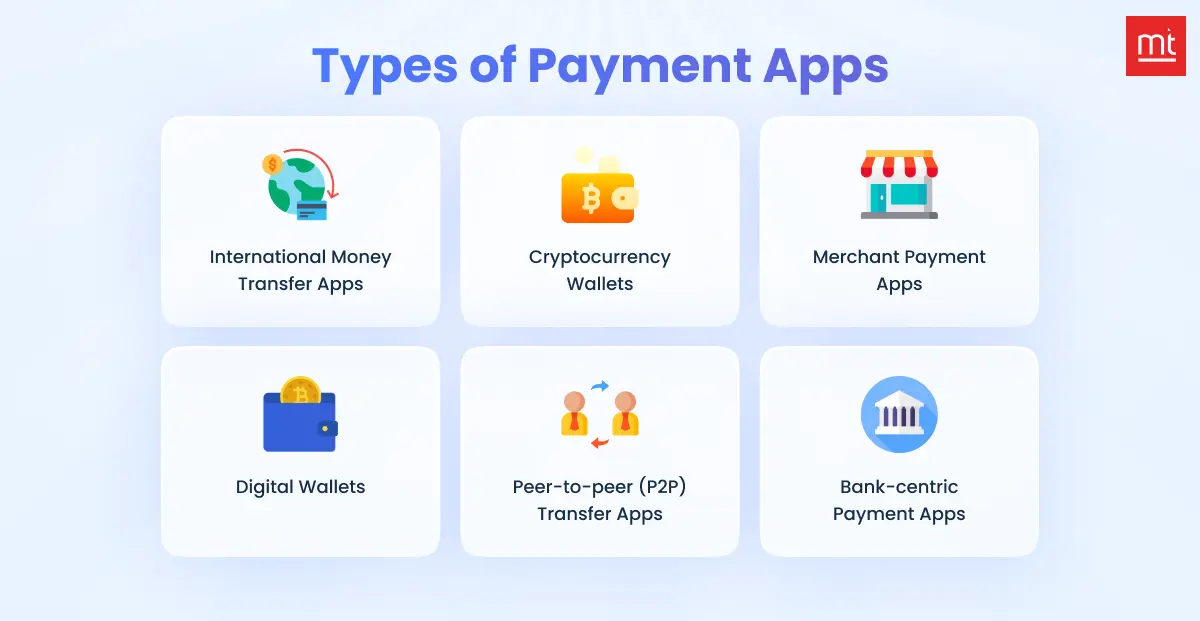
1. Digital Wallets
Digital wallets securely store users' payment information without requiring actual cards and enable fast transactions. Users may connect their bank accounts, credit or debit cards, or cryptocurrency to these wallets. Leading examples include Samsung Pay, Google Wallet, and Apple Pay, which improve in-store and online purchasing by enabling consumers to purchase with a simple touch or scan.
2. Peer-to-Peer (P2P) Transfer Apps
Apps for peer-to-peer transfers let users transmit money straight to others, sometimes with an email address or telephone number. Because these applications are quick and straightforward, splitting bills, paying for services, or sending money to friends and family has never been easier. Leading examples include Venmo, PayPal, and Zelle; each provides special features like rapid transfers, social transaction streams, and bank account connectivity.
3. Bank-Centric Payment App
Banks create bank-centric payment applications to provide their clients with a full range of mobile banking services. Usually, these applications include functionality like account management, cash transfers, bill payments, and balance checks. For instance, the Chase Mobile app and Bank of America Mobile Banking provide customers safe access to their banking services and financial data while moving.
4. International Money Transfer Apps
With affordable exchange rates and lower costs than conventional banks, international money transfer applications focus on cross-border transactions. To serve expatriates, companies, and people with worldwide financial demands, these applications make sending money abroad simpler and more reasonably priced. Reliability and a vast network of transfer corridors are hallmarks of TransferWise (now Wise) and Western Union.
5. Cryptocurrency Wallets
Cryptocurrency wallets enable people to transfer, receive, and store virtual currencies like Ethereum and Bitcoin. Frequently included in these wallets are safe storage, transaction history, and real-time market data. Coinbase and Binance are companies that provide wallet services and interface with cryptocurrency exchanges to help customers buy, sell, and trade a large variety of digital assets.
6. Merchant Payment Apps
Mobile payments from clients are made possible for companies via merchant payment applications. Generally speaking, credit/debit cards, digital wallets, and QR codes are supported by these applications. Popular examples include Square and Shopify POS, which provide complete point-of-sale transactions, inventory management, and sales analytics systems that help companies improve customer experience and simplify operations.
Must have Features While Developing Payment Apps
Payment applications can’t rule the market completely without user friendly features. Here are some of the most important features to include while developing payment apps:

1. User Login
Any payment app must have a safe user login. It guarantees that transactions may be completed and accounts accessed by only authorized users. Strong authentication techniques, like two-factor (2FA) and fingerprint (or face recognition), improve user confidence and security.
2. Account Control
User profiles may be managed, personal information updated, and preferences established via account management tools. This covers choices to manage related payment methods, update contact information, and change passwords. Giving consumers simple access to their account settings improves their control over their financial information.
3. Money Transfer
Swift and safe money transfers are a basic feature of payment applications. This covers requests for payment as well as bank and peer-to-peer transfers. Transfer processing must be done quickly and safely if users are to be satisfied.
4. Crypto Transaction Capabilities
With cryptocurrencies becoming increasingly popular, payment applications may draw in a larger user base by including crypto transaction features. Along with managing cryptocurrency portfolios and seeing real-time market data, features should include purchasing, selling, and transferring coins.
5. In-Store Payments
In-store payment features make Mobile device payments at retail establishments possible. These days, contactless payments may be made via Near near-field communication (NFC) or scanning QR codes. Smooth user experience requires ensuring seamless connection with point-of-sale (POS) systems.
6. Transaction Records
Transparency and user reference depend on including comprehensive transaction data. Viewing their transaction history, including dates, amounts, and transaction statuses, should be possible for users. With this function, consumers may monitor their expenditures and have any inconsistencies fixed.
7. Expense Sharing
Expense-sharing tools let users divide bills and split costs with coworkers, acquaintances, or family. This is very helpful for shared subscriptions, eating out, and travel. Expense division and settlement made it easier to improve consumer comfort.
8. Track and Optimise Spending
Users of tools for monitoring and optimizing expenditure can better handle their money. Users may track their spending patterns and make wise financial choices with tools like budget preparation, expenditure classification, and financial analytics.
9. Real-time Updates
Users are kept informed about their account activity and transactions via real-time updates and alerts. Payment, transfer, and other account change notifications instantly improve security and user awareness by enabling users to respond quickly to unusual behavior.
10. Transaction Records
Both regulatory compliance and user trust depend on keeping thorough transaction records up to date. All transactions should be fully documented for users to utilize for tax and personal accounting and dispute resolution.
Cost of Payment App Development
The app's complexity, the development team's location, and the necessary functionality may all significantly impact how much UPI payment app development costs. Here's a thorough explanation:
Team Type | Estimated Cost (USD) |
In-house Development | $200,000 - $500,000 |
Freelancers | $50,000 - $200,000 |
Offshore Development | $80,000 - $250,000 |
Local Development | $150,000 - $400,000 |
Cost Based on Team Location
Location | Hourly Rate (USD) | Estimated Total Cost (USD) |
North America | $100 - $250 | $300,000 - $700,000 |
Western Europe | $80 - $200 | $240,000 - $600,000 |
Eastern Europe | $40 - $100 | $120,000 - $300,000 |
Asia (India) | $20 - $50 | $60,000 - $150,000 |
Latin America | $30 - $80 | $90,000 - $240,000 |
Challenges while Developing Payments Apps
Payment app development comes with certain challenges that may give you a hard time. To help you stay on track with Payment app development, you need to take care of challenges that come your way.
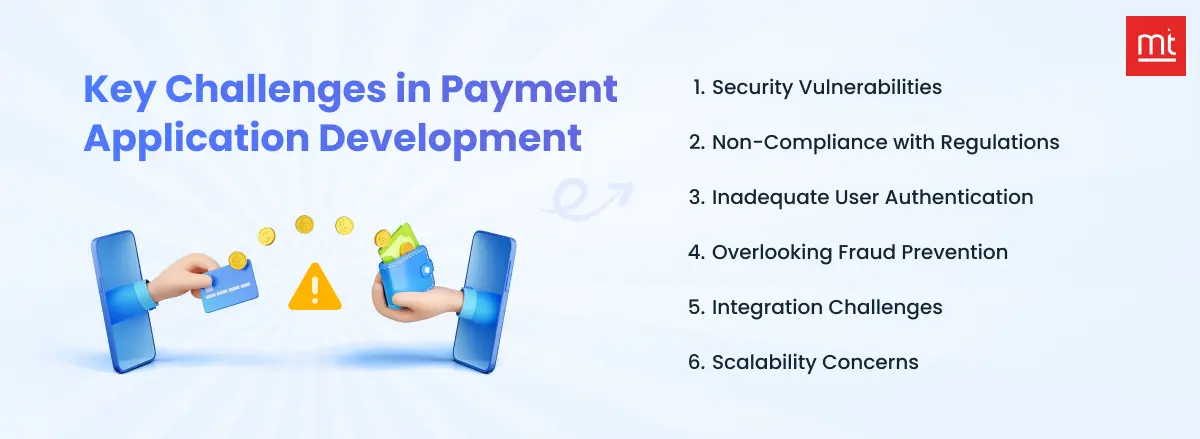
1. Security Vulnerabilities
Developing payment apps requires top-priority security. Protection of Sensitive financial data against hacks and breaches requires strong encryption techniques, safe coding procedures, and regular security assessments. To preserve regulatory compliance and user confidence, developers must keep one step ahead of changing security risks.
2. Non-Compliance with Regulations
Payment applications must follow PCI-DSS, PSD2, and GDPR, among other financial rules and standards. Serious fines and legal problems might result from noncompliance. Developers must make sure their applications follow these rules by including from the beginning the required security measures, data protection procedures, and privacy policies.
3. Inadequate User Authentication
Fraudulent transactions and illegal access may result from inadequate user authentication. Implementing robust authentication techniques, like biometric verification and multi-factor authentication (MFA), is essential to preventing unwanted access and improving security. User pleasure depends critically on a smooth and safe login process.
4. Overlooking Fraud Prevention
Users and the platform must be protected from fraudulent activity by fraud protection measures. Anomalies identification, transaction monitoring, and real-time fraud warnings are features that developers must provide. Artificial intelligence and machine learning enable applications to identify and stop fraudulent activity more successfully.
5. Integration Challenges
Complex integrations of payment applications with many payment gateways, banks, and outside services may occur. Efficient and safe integration calls for careful preparation and implementation. For a seamless user experience across many platforms and services, developers must handle compatibility problems, API constraints, and data synchronization.
6. Scalability Concerns
Scalability becomes important when the number of users and transactions increases. App architects must be able to manage growing loads without sacrificing performance. Cloud services, database performance optimization, and scalable infrastructure may all assist in guaranteeing that the program can expand.
Best Practices: Steps to Develop Payment Apps
Developing payment applications requires you to go through the end to end steps. Here are steps developer can follow to develop payment apps:
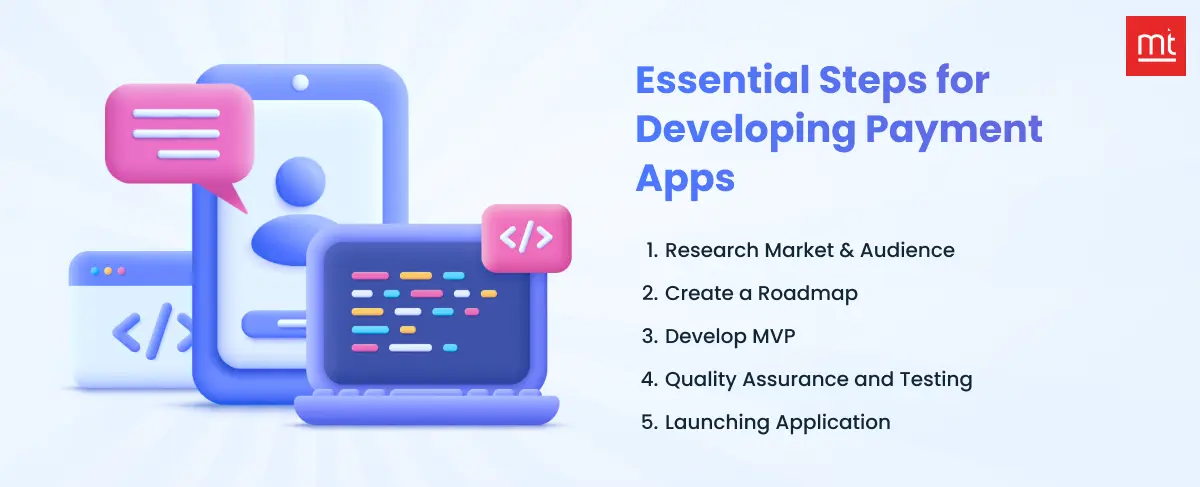
Step 1: Research the Market and the Audience
Creating a payment application starts with carrying out extensive market research. Designing features that meet the target audience's goals, preferences, and pain points is made easier with knowledge about them. Understanding the advantages and disadvantages of rivals helps one understand market trends and chances for differentiation.
Step 2: Create a Roadmap
Formulating a thorough roadmap is necessary to direct the development process. The project schedule, significant checkpoints, and deliverables should be included in the roadmap. Clear goals are established, resources are managed effectively, and the development is continued with its support. Furthermore important is to update the roadmap regularly according to input and progress.
Step 3: Develop MVP
Developing a Minimum Viable Product (MVP) early on enables developers to evaluate the essential features and get user input. An MVP consists of the basic features that meet the main requirements of the users. By releasing an MVP, developers may find any problems, verify presumptions, and decide what has to be improved.
Step 4: Quality Assurance and Testing
The function, security, and performance of the app depend on rigorous quality assurance and testing. This covers testing of user acceptability, integration, and units. Continuous integration techniques and automated testing instruments may make the testing process faster. Trust and user happiness depend on the app's bug and vulnerability-free status.
Step 5: Launching Application
Deploying the program to the target platforms—web servers and app stores, for example—is known as launching it. A launch went well calls for careful planning in areas like user onboarding, marketing plans, and customer service. Planning next upgrades and spotting opportunities for development are made easier with user input obtained after the launch.
Why Choose Manek Tech for Payment App Development?
Manek Tech is the leading app development company with prime expertise in developing payment applications for businesses delivering cutting edge user experience. With a dedicated team of developers, we take pride in developing UPI payments with advanced features to meet your requirements. As a top payment app development company, ManekTech holds all the expertise to give a boost to your payment app development idea.
ManekTech has a wealth of expertise in creating sophisticated payment solutions for several industries. They have implemented safe transaction processes, guaranteed regulatory compliance, and integrated payment gateways. Their background assures their payment apps' functionality, dependability, and security.
ManekTech specializes in developing solutions specifically for companies. They know that payment applications have different requirements based on target markets, demographics, and business goals. Their software is customized to the operational and visionary requirements of the customer.
Conclusion
A payment app's development requires negotiating challenging, expensive, and feature-rich terrain. For an app to be effective and satisfy both user wants and regulatory standards, one must understand the key features, development process, and cost considerations. Businesses may create strong and intuitive payment applications by adhering to best practices and anticipating any issues. At ManekTech, we are your ultimate partner in developing mobile applications packed with cutting edge features and technology to meet your payment transfer requirements. Contact us today to develop payment applications.
About Author
Recent Blogs
Subscribe to Our Newsletter!
Join us to stay updated with our latest blog updates, marketing tips, service tips, trends, news and announcements!


